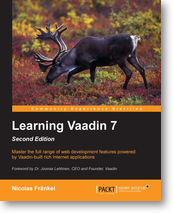Spring Boot and JavaConfig integration
Submitted on 08 March 2014Java EE in general and Context and Dependency Injection has been part of the Vaadin ecosystem since ages. Recently, Spring Vaadin is a joint effort of the Vaadin and the Spring teams to bring the Spring framework into the Vaadin ecosystem, lead by Petter Holmström for Vaadin and Josh Long for Pivotal.
Integration is based on the Spring Boot project - and its sub-modules, that aims to ease creating new Spring web projects. This article assumes the reader is familiar enough with Spring Boot. If not the case, please take some time to get to understand basic notions about the library.
Note that at the time of this writing, there’s no release for Spring Vaadin. You’ll need to clone the project and build it yourself.
The first step is to create the UI. In order to display usage of Spring’s Dependency Injection, it should use a service dependency. Let’s injection the UI through Constructor Injection to favor immutability. The only addition to a standard UI is to annotate it with org.vaadin.spring.@VaadinUI.
@VaadinUI
public class VaadinSpringExampleUi extends UI {
private HelloService helloService;
public VaadinSpringExampleUi(HelloService helloService) {
this.helloService = helloService;
}
@Override
protected void init(VaadinRequest vaadinRequest) {
String hello = helloService.sayHello();
setContent(new Label(hello));
}
}The second step is standard Spring Java configuration. Let’s create two configuration classes, one for the main context and the other for the web one. Two thing of note:
- The method instantiating the previous UI has to be annotated with
org.vaadin.spring.@UIScopein addition to standard Springorg.springframework.context.annotation.@Beanto bind the bean lifecycle to the new scope provided by the Spring Vaadin library. - At the time of this writing, a
RequestContextListenerbean must be provided. In order to be compliant with future versions of the library, it’s a good practice to annotate the instantiating method with@ConditionalOnMissingBean(RequestContextListener.class).
@Configuration
public class MainConfig {
@Bean
public HelloService helloService() {
return new HelloService();
}
}
@Configuration
public class WebConfig extends MainConfig {
@Bean
@ConditionalOnMissingBean(RequestContextListener.class)
public RequestContextListener requestContextListener() {
return new RequestContextListener();
}
@Bean
@UIScope
public VaadinSpringExampleUi exampleUi() {
return new VaadinSpringExampleUi(helloService());
}
}The final step is to create a dedicated WebApplicationInitializer. Spring Boot already offers a concrete implementation, we just need to reference our previous configuration classes as well as those provided by Spring Vaadin, namely VaadinAutoConfiguration and VaadinConfiguration.
public class ApplicationInitializer extends SpringBootServletInitializer {
@Override
protected SpringApplicationBuilder configure(SpringApplicationBuilder application) {
return application.showBanner(false)
.sources(MainConfig.class)
.sources(VaadinAutoConfiguration.class, VaadinConfiguration.class)
.sources(WebConfig.class);
}
}At this point, we demonstrated a working Spring Vaadin sample application.
Code for this article can be browsed and forked on Github.
